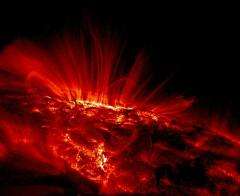September 15, 2010 report
Sunspots could soon disappear for decades: study

(PhysOrg.com) -- Sunspot formation is triggered by a magnetic field, which scientists say is steadily declining. They predict that by 2016 there may be no remaining sunspots, and the sun may stay spotless for several decades. The last time the sunspots disappeared altogether was in the 17th and 18th century, and coincided with a lengthy cool period on the planet known as the Little Ice Age.
Sunspots are regions of electrically charged, superheated gas (plasma) on the surface of the sun, formed when upwellings of the magnetic field trap the ionized plasma. The magnetic field prevents the gas from releasing the heat and sinking back below the sun’s surface. These areas are somewhat cooler than the surrounding sun surface and so appear to us as dark spots.
Sunspots have been observed at least since the early 17th century, and they are known to follow an 11 year cycle from solar maximum to solar minimum. The solar minimum usually lasts around 16 months, but the current minimum has already lasted 26 months, which is the longest minimum in a hundred years.
Since 1990, Matthew Penn and William Livingston, solar astronomers with the National Solar Observatory (NSO) in Tucson, Arizona, have been using a measurement known as Zeeman splitting to study the magnetic strength of sunspots. The Zeeman splitting is the distance between a pair of infrared spectral lines in a spectrograph taken of the light emitted by iron atoms in the atmosphere of the sun. The wider the distance, the greater is the intensity of the magnetic field.
Penn and Livingston examined 1500 sunspots and found that the average strength of the magnetic field of the sunspots has dropped from around 2700 gauss to 2000 gauss. (In comparison, the Earth’s magnetic field is below one gauss.) The reasons for the decline are unknown, but Livingston said that if the strength continues to decrease at the same rate it will drop to 1500 gauss by 2016, and below this strength the formation of sunspots appears to be impossible.
During the period from 1645 to 1715, a time known as the Maunder Minimum, there were almost no sunspots. This period coincided with the Little Ice Age, which produced lower than average temperatures in Europe. Livingston said their results should be treated with caution as their techniques are relatively new and it is not yet known if the decline in magnetic field strength will continue, and that “only the passage of time will tell whether the solar cycle will pick up.”
David Hathaway, a solar physicist with the Marshall Space Flight Center in Huntsville, Alabama, also cautioned the calculations do not take into account that many small sunspots with relatively weak magnetic fields appeared during the last solar maximum, and if these are not included in the calculations the average magnetic field strength would seem higher than it actually was.
Penn and Livingston’s paper has been submitted to the online colloquium, International Astronomical Union Symposium No. 273.
More information: Long-term Evolution of Sunspot Magnetic Fields, Matthew Penn and William Livingston, arXiv:1009.0784v1 [astro-ph.SR]
© 2010 PhysOrg.com





















